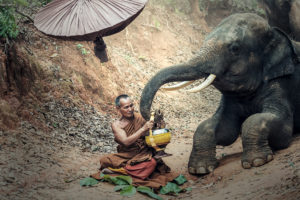Karma is one of the three philosophies of Hinduism, along with Dharma and Moksha. The term refers to the sum of the punya (good deeds) and papaha (evil deeds) done by a person. The god of Karma is Shani, a divine personification of the planet Saturn. Bhagvan Shani uses a crow as the vehicle and delivers justice or dharma depending on the accumulated karma. All are delivered justice, irrespective of their status, such as god, beggar, or king. This article reviews the concept of karma and the metaphysical forces associated with it.
Ancient origins: The Rigveda, an ancient Sanskrit text written around 2000 BC, first mentions Karma. In smaskara, or the world, evil and good deeds done by a person act as debit or credit through the cycle of birth and death. The physical body is consumed by the fire or earth after death, but the soul experiences rebirth or punarajati, re-death, punar-mrtyu, and coming to life again, punar-asu. Thus, karma is the metaphysical force that guides the soul. A murderer, thief, traitor, or one who has done bad deeds will be reborn as a worm, snake, demon, evil spirit, or insect and undergo various punishments and miseries.
Other than bad and good karma, there are three types, and these are explained as follows. Sanchita karma includes the sum of all good and bad actions from the previous lives. A person will have done many good or bad deeds in their lives, and one portion of this is bequeathed to the next karma or prarabdha karma. Prarabdha karma is the being’s current karma, but it is shaped by the actions of previous lives and karmas. In other words, you either reap the benefits or suffer from the deeds done in past incarnations. This is also called destiny or fate, and it cannot be avoided or changed. Agami karma is the sum of the present and past deeds, and they are carried into the next rebirth.
How it works: The Rigveda explains these constructs through an analogy. A hunter has a number of arrows in his quiver, and these arrows are the sanchita. He fires an arrow from the bow, and it cannot be stopped or recalled, and this arrow is prarabdha. When this arrow strikes a target, it becomes the agami and gives the fruits of his endeavors. Through a sublime conscience, the hunter has developed his skills, sharpened and shaped the arrows, and used his experience to build the sanchita, prarabdha, and to obtain agami, and he therefore has full control over all these forces. This, however, cannot occur in real life because he has no recollection of his previous lives or the karma of his life and deeds.
Karma is not like a business and trade record where one can refer to business losses and make corrections to make profits. The scriptures say that only prarabdha is the actual presence since it is the current life and a person has to perform good deeds, surround herself with positive energy, harness the natural forces of all things, and develop the synergy to lead a better life in the next reincarnation.
Moksha: Moksha, also called mukti, nirvana, is a soteriological and eschatological release and liberation from the cycle of life and death. The cycle is unpredictable and based on voluntary and involuntary actions. People may experience happiness, misery, sorrow, diseases, illness, and other forms of mental and physical torture. When moksha is attained, then a person reaches a natural state by leaving the imposed state of the prarabdha karma. A being that has attained moksha is immersed in the contentment of the self, freedom from moral obligation, and the need to prove one’s worth in samsara.
Moksha can be attained through jnana, bhakti, and karma. Jnana, or knowledge, is obtained through rigorous studies of the Vedas, Upanishads, Brahamanas, and other texts. Many ancient and mythological rishis, such as Atri, Bharadvaja, Bhrigu, Gotama, Kashyapa, Vasishtha, and Vishvamitra, who form the seven gotras, attained moksha through study, and this may not be possible for us. Bhkati is through devotion and severe penance as seen by ascetics, and again, this route may not be possible for all. Karma is the attainment of moksha through good deeds in the present life. Thus, a person can increase karma through perceived good deeds to attain moksha. An important concept is that a person may not gain rewards or suffer punishment in the present life due to actions and deeds. Rather, the effects of these deeds are carried over to the next life. Another aspect is that birth in a specific caste does not guarantee good karma. Therefore, even a Brahmin, the highest among the Hindu classes, will suffer from evil and bad acts, while a Shudra, the lowest among the classes, can gain good karma.
The question now is, what exactly are good deeds? A dichotomy seen since moksha is about giving up desires. However, karma is about doing good deeds to attain moksha. One obvious route is to do perceived good through donations, gifts, and helping the weak, poor, and undeserving. However, the giver’s intention, attitude, and desires for donation should not be selfish and designed to only attain a specific goal. Does a crooked lawyer who uses her skills to free a criminal by using her skills give her moksha? Does a corrupt politician who donates funds obtained from corruption to help the poor give him moksha? Does a drug lord, a dictator who has killed hundreds overturn bad karma by doing good deeds as atonement for his sins?
The story of Ratnakara, a murderous dacoit who later became the scribe of the Ramayana and Sage Valmiki, exemplifies the possibility of such a dramatic transformation. He was adopted by a hunter who married and had a growing family whom he could not feed through his hunting and became a bandit. One day, Ratnakara attempted to rob and kill Narada, the musician sage of the gods, who asked him if his family accepted the fruits of his robbery and sins. Ratnakara was aghast when his wife, children, and all relatives refused him, saying that they would share the profits but not the guilt of a sin. Totally heartbroken, Ratnakara went to Narada and begged for forgiveness and a way to atone for his sins, Narada asked him to sit under a tree, do penance, become an ascetic, and pray to Bhagvan Rama to give him salvation. Eons passed and an anthill grew over the dacoit, but he kept meditating. Narada then came and freed him, giving him the name of Valmiki, the one who had emerged from an anthill and later wrote the Ramayana. Thus, it is possible for the penitent to transform if they truly regret and mend their ways.
To conclude, do not covet what is not yours, do not deceive the gullible. Work hard and obtain a just profit. This may result in good karma and help in obtaining peace of mind, benevolence, bliss, and possibly moksha.



